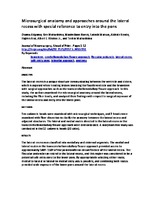Repositorio Digital
Microsurgical anatomy and approaches around the lateral recess with special reference to entry into the pons
- DSpace Principal
- →
- Hospital El Cruce
- →
- Publicaciones
- →
- Artículos
- →
- Ver ítem
JavaScript is disabled for your browser. Some features of this site may not work without it.
Mostrar el registro sencillo del ítem
| dc.contributor.author | Akiyama, Osamu | |
| dc.contributor.author | Matsushima, Ken | |
| dc.contributor.author | Nuñez, Maximiliano | |
| dc.contributor.author | Matsuo, Satoshi | |
| dc.contributor.author | Kondo, Akihide | |
| dc.contributor.author | Arai, Hajime | |
| dc.contributor.author | Rhoton, Albert | |
| dc.contributor.author | Matsushima, Toshio | |
| dc.date.accessioned | 2018-04-12T17:41:42Z | |
| dc.date.available | 2018-04-12T17:41:42Z | |
| dc.date.issued | 2017-11-17 | |
| dc.identifier.other | http://thejns.org/doi/abs/10.3171/2017.5.JNS17251 | |
| dc.identifier.other | 10.3171/2017.5.JNS17251 | |
| dc.identifier.uri | http://repositorio.hospitalelcruce.org/xmlui/handle/123456789/642 | |
| dc.description | Fil: Nuñez, M. Hospital de Alta Complejidad en Red El Cruce Dr. Néstor C. Kirchner. Servicio de Neurocirugía. Florencio Varela, Argentina. | ES |
| dc.description.abstract | OBJECTIVE The lateral recess is a unique structure communicating between the ventricle and cistern, which is exposed when treating lesions involving the fourth ventricle and the brainstem with surgical approaches such as the transcerebellomedullary fissure approach. In this study, the authors examined the microsurgical anatomy around the lateral recess, including the fiber tracts, and analyzed their findings with respect to surgical exposure of the lateral recess and entry into the lower pons. METHODS Ten cadaveric heads were examined with microsurgical techniques, and 2 heads were examined with fiber dissection to clarify the anatomy between the lateral recess and adjacent structures. The lateral and medial routes directed to the lateral recess in the transcerebellomedullary fissure approach were demonstrated. A morphometric study was conducted in the 10 cadaveric heads (20 sides). RESULTS The lateral recess was classified into medullary and cisternal segments. The medial and lateral routes in the transcerebellomedullary fissure approach provided access to approximately 140º–150º of the posteroinferior circumference of the lateral recess. The floccular peduncle ran rostral to the lateral recess, and this region was considered to be a potential safe entry zone to the lower pons. By appropriately selecting either route, medial-to-lateral or lateral-to-medial entry axis is possible, and combining both routes provided wide exposure of the lower pons around the lateral recess. CONCLUSIONS The medial and lateral routes of the transcerebellomedullary fissure approach provided wide exposure of the lateral recess, and incision around the floccular peduncle is a potential new safe entry zone to the lower pons. | es_AR |
| dc.language.iso | en_US | es_AR |
| dc.publisher | Journal of Neurosurgery | es_AR |
| dc.subject | Microsurgery | es_AR |
| dc.subject | Microcirugia | es_AR |
| dc.subject | Neurocirugia | es_AR |
| dc.subject | Neurosurgery | es_AR |
| dc.subject | Accidente Cerebrovascular | es_AR |
| dc.subject | Stroke | es_AR |
| dc.title | Microsurgical anatomy and approaches around the lateral recess with special reference to entry into the pons | es_AR |
| dc.type | Article | es_AR |
Ficheros en el ítem
Este ítem aparece en la(s) siguiente(s) colección(ones)
-
Artículos
Articles

